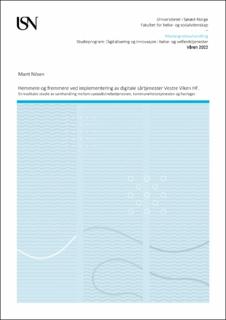| dc.contributor.advisor | Dugstad, Janne Herholdt | |
| dc.contributor.author | Nilsen, Marit | |
| dc.date.accessioned | 2022-08-11T16:42:31Z | |
| dc.date.available | 2022-08-11T16:42:31Z | |
| dc.date.issued | 2022 | |
| dc.identifier | no.usn:wiseflow:6537723:49184500 | |
| dc.identifier.uri | https://hdl.handle.net/11250/3011400 | |
| dc.description.abstract | Bedre samhandling på tvers av helsetjenestene har blitt en politisk og helsefaglig kjernesak, samtidig er det et stort fokus på å ta i bruk teknologier som muliggjør å utføre og levere tjenester på avstand. Etterspørsel etter koordinerte helsetjenester og politiske føringer har ført fram til implementering av ulike bidrag av digitale sårtjenester både nasjonalt og internasjonalt. Det er et evidensbasert grunnlag som taler for at digitale sårtjenester kan være et effektivt virkemiddel i behandling av kroniske sår, som også gir økt kompetanseheving hos helsepersonell, stimulerer til samhandling mellom aktørene i helseapparatet, og begrenser antall reiser til pasienter. Det er derimot få publiserte studier som har analysert organisatoriske aspekter ved implementering av digitale sårtjenester, hvor ulike aktører samhandler. Masteroppgaven søker derfor å bidra til å identifisere, forstå og adressere mulige hemmere og fremmere aktørene i tjenesten har erfart ved implementering.
Gjennom en kvalitativ tilnærming, og semistrukturerte intervjuer med informanter er det forsket på implementering av digitale sårtjenester i Vester Viken HF. Determinantrammeverket Consolidated Framework for Implementation Research (Damschroder et al., 2009), hvor Rammeverk for digital samhandling (Digitaliseringsdirektoratet, 2022) var inkorporert som determinanter til analysering og koding av data.
Det er i alt indentifisert 13 determinanter som har hemmet (6) og fremmet (7) implementeringen av digitale sårtjenester. Oppgaven viser at implementering av digitale sårtjenester kan adressere komplekse og omfattende utfordringer. Implementering av ny teknologi i samhandlende helsetjenester er en langsom prosess, spesielt med tanke på at tjenesten inneholder flere aktører, som må levere til samme tid, og at problemstillingene er komplekse, sammensatt og vevd inn i ulike kulturelle, politiske og økonomiske kontekster. Videre viser analysen en betydelig fordel med en tilgjengelig, samlende og løsningsorientert prosjektleder. Et godt nettverk og kommunikasjon mellom aktørene, tilgang på kunnskap og informasjon, samt aktørenes tro på tjenesten og engasjerte ledere kan bidra positivt til implementeringen av digitale sårtjenester.
Nøkkelord: Digitale sårtjenester, samhandling, implementering, determinant, hemmere og fremmere | |
| dc.description.abstract | To create better cooperation across different health services has become a topic of great political and medical importance, while at the same time delivering home based services through the utilization of technology. The demand for coordinated health services and political dictation has led to the implementation of both national and international digital wound care. There is evidence to support that the digitalization of wound care can prove to be an efficient tool in the treatment of chronic wounds; in addition to raising the competency of health professionals, stimulating collaboration between actors within the health industry while at the same time limiting patient travel. Unfortunately, there are few studies examining the implementation of digital wound care from an organizational perspective. This paper therefore seeks to identify, understand and address what possible inhibiting and facilitating factors the actors experience through this digitalization.
The purpose of the master´s thesis is to examine the implementation of digital wound care in Vestre Viken HF through a qualitative approach, using conducting semi-structured interviews. Consolidated Framework for Implementation Research, where the Norwegian interoperability framework is incorporated as determinants are used for analyzing and coding the data.
In total, 13 determinants have been identified; 6 inhibited and 7 facilitated the implementation of digital wound care. This paper shows that the implementation of digital wound care can address complex and extensive challenges. This implementation of new technology is a slow process, especially considering all the different actors within the health sector and their respective tasks and needs. These challenges are intricate and woven into different cultural, political and economic contexts. In spite of these complications, the analysis demonstrates the need of a goal oriented, diplomatic and skilled project manager. Furthermore the data supports that a functioning network, communication amongst actors and their belief in the service, as well as enthusiastic leaders all will contribute to a positive implementation of telemedicine within wound care.
Key words: Digital wound care, cooperation, implementation, determinant, inhibitors and facilitators. | |
| dc.language | nob | |
| dc.publisher | University of South-Eastern Norway | |
| dc.title | Hva hemmer og fremmer implementering av en digital sårbehandlingstjeneste der kommunehelsetjenesten, spesialisthelsetjenesten og fastleger samhandler? | |
| dc.type | Master thesis | |
